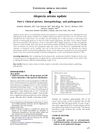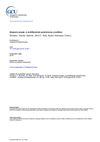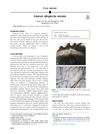TLDR Alopecia areata mainly affects young people and has significant psychological impacts, especially in males.
The study examined 219 Asian patients with alopecia areata in Singapore, revealing an incidence rate of 3.8% and a male-to-female ratio of 1:1.3. Most patients were Chinese (79%), with a median age of 25.2 years, and 85.5% experienced their first episode before age 40. Extensive alopecia was more common in younger patients, and 10.5% had nail changes. A significant number had a personal or family history of atopy (60.7%), but no strong link was found between atopy and alopecia extent. Associated diseases included thyroid disease (2.3%) and vitiligo (4.1%). Treatments like intralesional triamcinolone acetonide and squaric acid dibutyl ester showed significant improvement in hair regrowth. Stressful events were recalled by 9.8% of respondents, and extensive alopecia led to more psychological effects, particularly in males. The study concluded that alopecia areata predominantly affected young individuals and emphasized the importance of a holistic management approach due to its psychological impact.
 391 citations
,
January 2010 in “Journal of The American Academy of Dermatology”
391 citations
,
January 2010 in “Journal of The American Academy of Dermatology” Half of people with Alopecia Areata may see hair regrowth within a year without treatment, but recovery is unpredictable.
117 citations
,
February 1996 in “International Journal of Dermatology” A 300 mg monthly pulse of prednisolone effectively and safely treats widespread alopecia areata.
 222 citations
,
October 1993 in “Journal of The American Academy of Dermatology”
222 citations
,
October 1993 in “Journal of The American Academy of Dermatology” Hair loss affects women's mental health more than men's, causing anxiety, low self-esteem, and social insecurity.
161 citations
,
March 1992 in “International Journal of Dermatology” Alopecia areata often starts before age 20, is more common in women, and may have a genetic link with other autoimmune diseases.
164 citations
,
November 1989 in “Clinical and Experimental Dermatology” Juvenile alopecia areata is more severe and has a worse prognosis than maturity-onset alopecia areata.
42 citations
,
August 1987 in “Archives of Dermatology” Squaric acid dibutylester led to complete hair regrowth in 28.5% of patients with alopecia areata.
 148 citations
,
December 2018 in “Journal of autoimmunity”
148 citations
,
December 2018 in “Journal of autoimmunity” Alopecia areata is an autoimmune disease causing patchy hair loss, often with other autoimmune disorders, but its exact causes are unknown.
 4 citations
,
November 2018 in “JAAD case reports”
4 citations
,
November 2018 in “JAAD case reports” Alopecia areata can sometimes appear as a straight line of hair loss instead of round patches.
May 2018 in “Journal of cosmetology & trichology” Combining platelet-rich plasma therapy with prostaglandin-F eye drops can significantly regrow hair in alopecia universalis.



